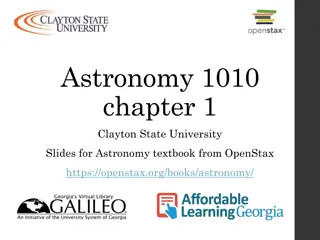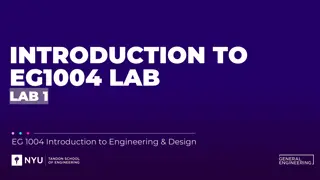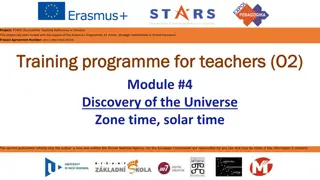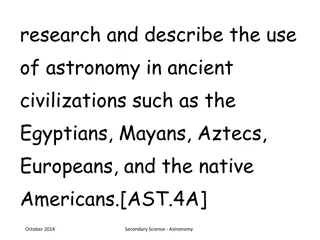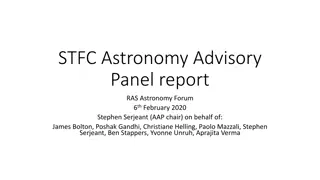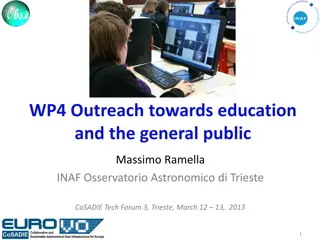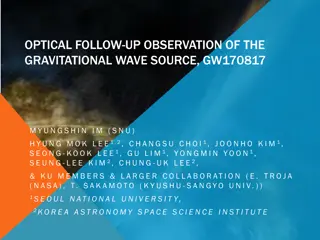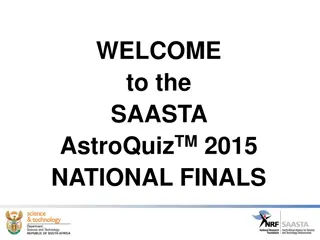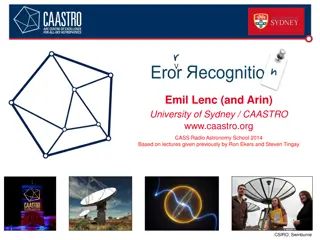Astronomy Lab Information and Schedule
In this astronomy lab course, students will explore various topics related to celestial objects, constellations, planispheres, and observational projects. The labs involve practical activities such as observing the phases of the Moon, visiting observatories, and understanding celestial coordinates. Extra credit opportunities and grading information are also provided. Regular attendance and active participation are essential for successfully completing the course.
Download Presentation

Please find below an Image/Link to download the presentation.
The content on the website is provided AS IS for your information and personal use only. It may not be sold, licensed, or shared on other websites without obtaining consent from the author.If you encounter any issues during the download, it is possible that the publisher has removed the file from their server.
You are allowed to download the files provided on this website for personal or commercial use, subject to the condition that they are used lawfully. All files are the property of their respective owners.
The content on the website is provided AS IS for your information and personal use only. It may not be sold, licensed, or shared on other websites without obtaining consent from the author.
E N D
Presentation Transcript
Lab Intro & Lab 1: Celestial Sphere & Planispheres Tiffany Pewett pewett@astro.gsu.edu 25 Park Place, 625E
General Lab Info If you don t already have the book you need to get one and make sure you bring it to each lab. Please do all labs in pencils, scratched out pen is hard to grade. Put your name and preferred email address on the first lab. Do your own work!
Lab Points 11 labs total, lowest lab is dropped, each worth 10 points = 100 points Observatory project: 10 points Lab 24 ( Moon Project ): 20 points Total points= 130 This means each lab is worth ~7.5% of your lab grade so it is in your best interest to attend every lab.
Observatory Project Lab 28 in your book, make sure you take this lab with you. Visit any observatory, get a signature from the astronomer on duty, ask questions to fill in your report. Reports must be written in FULL sentences for full 10 points.
Lab 24: Observing the Phases of the Moon Take pictures of the Moon at each of the 7 main phases (not including New Moon). At least 1 must in the daytime. Build the gradient and use it to measure Moon altitude in each picture. Fill out remaining info and answer the questions at the end. Due on the last day of lab.
Extra Credit There is enough extra credit offered to make up one full lab. 4 points to attend an HLCO Open House. 3 points to visit a 2nd(different) observatory. 2 points for building your gradient and bringing it to lab early. 1 point for bringing in an early Moon picture.
Lab Information All the information you might need about the lab can be found at my lab website. If you need help with something that is not there you are more than welcome to email me or stop by my office during office hours.
Todays Lab (Lab 1) Are constellations important in Astronomy? How do Astronomers use them?
Celestial Coordinates Right Ascension (RA) East-West coordinates on the sky. Measured in units of time (Hours:Minutes:Sec.) Declination (Dec) North (+), South (-) coordinates on the sky. Measured in units of angle (Degrees:Arcminutes:Arcseconds or : : ) Origin is at RA=00h:00m:00s, Dec=00 :00 :00
Celestial Sphere Projection of the Earth s coordinates onto sky. Origin at the Vernal Equinox. Earth s Equator= Celestial Equator Ecliptic= Location of planets, Moon, & Sun.
Current Planet Positions Mercury: RA= 21H:46M, Dec= -14 :18 Venus: RA= 18H:58M, Dec= -15 :46 Mars: RA= 13H:23M, Dec= -06 :06 Jupiter: RA= 06H:56M, Dec= 23 :00 Saturn: RA= 15H:22M, Dec= -16 :10
Planispheres Tool used to locate constellations and other objects in the current night sky. Set time and date by rotating. Circumpolar constellations never set.


